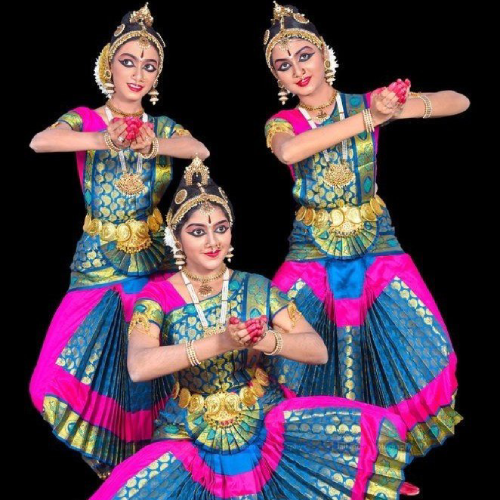Bharatanatyam (also spelled Bharathanatyam, Bharatnatyam or Bharata Natyam is a classical dance form originating from Tamil Nadu of Southern India. It owes its current name to Krishna Iyer and later, Rukmini Devi Arundale. Bharata refers to the author of the Natya Shastra, and natya is Sanskrit for the art of dance-drama. It was brought to the stage at the beginning of the 20th century by Krishna Iyer. Bharatanatyam is thought to have been created by Bharata Muni, a Hindu sage, who wrote the Natya Shastra, the most important ancient treatise on classical Indian dance. It is also called the fifth Veda in reference to the foundation of Hindu religion and philosophy, from which sprang the related South Indian musical tradition of Carnatic music. However, there are references to Rishi Agastya teaching his disciples a different form of sacred dance than the one taught by Bharata Muni.
In ancient times it was performed as dasiattam by mandir (Hindu temple) Devadasis. Many of the ancient sculptures in Hindu temples are based on Bharata Natyam dance postures. In fact, it is the celestial dancers, apsara’s, who are depicted in many scriptures dancing the heavenly version of what is known on earth as Bharatanatyam. Dance originated and became a part of the temple because its aim was to attain spiritual identification with the eternal. The center of all arts in India is Bhakti (devotion) and therefore, Bharata Natyam as a dance form and carnatic music set to it are deeply grounded in Bhakti. Bharata Natyam, it is said, is the embodiment of music in visual form, a ceremony, and an act of devotion. Dance and music are inseparable forms; only with Sangeetam (words or syllables set to raga or melody) can dance be conceptualized. Bharata Natyam has three distinct elements to it: Nritta (rhythmic movements of pure aesthetic value), Nritya (movements in which abhinaya or expression is emphasized), and Natya (dance with a dramatic aspect). The word Bharata, interpreted as the dance form created by sage Bharata, has within it the essence and uniqueness associated with Bharatanatyam: Bha for Bhava or abhinaya and expression, Ra for raga or melody, and Ta for tala or rhythm.






